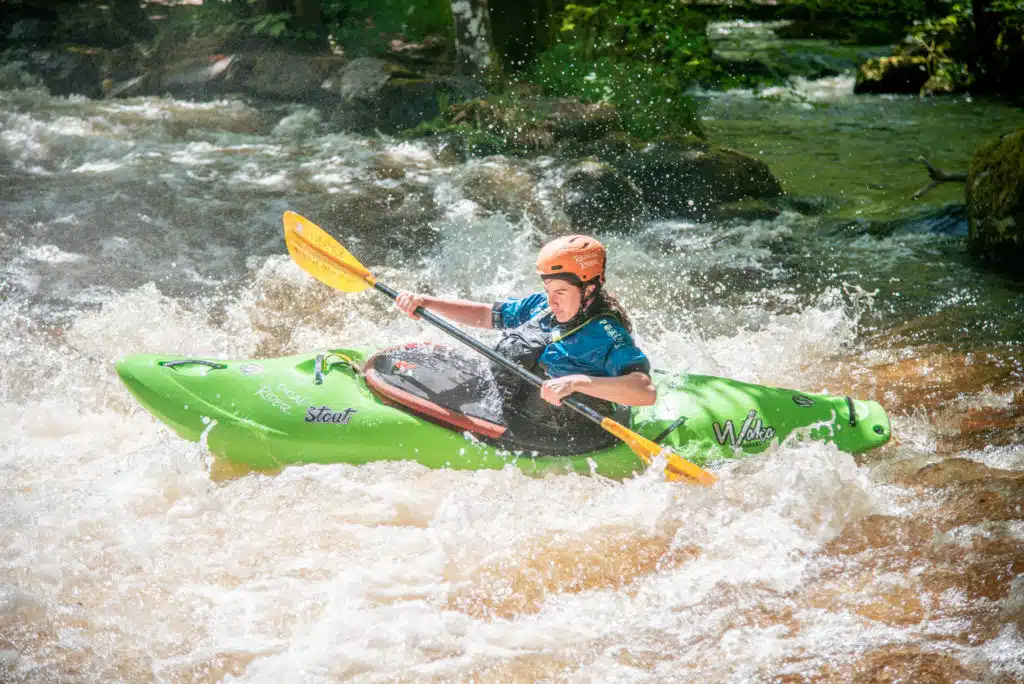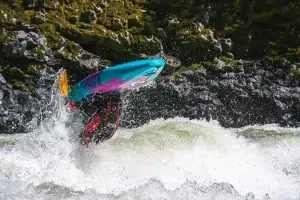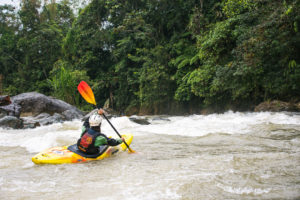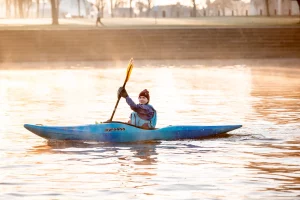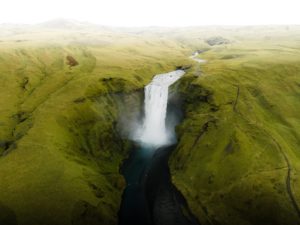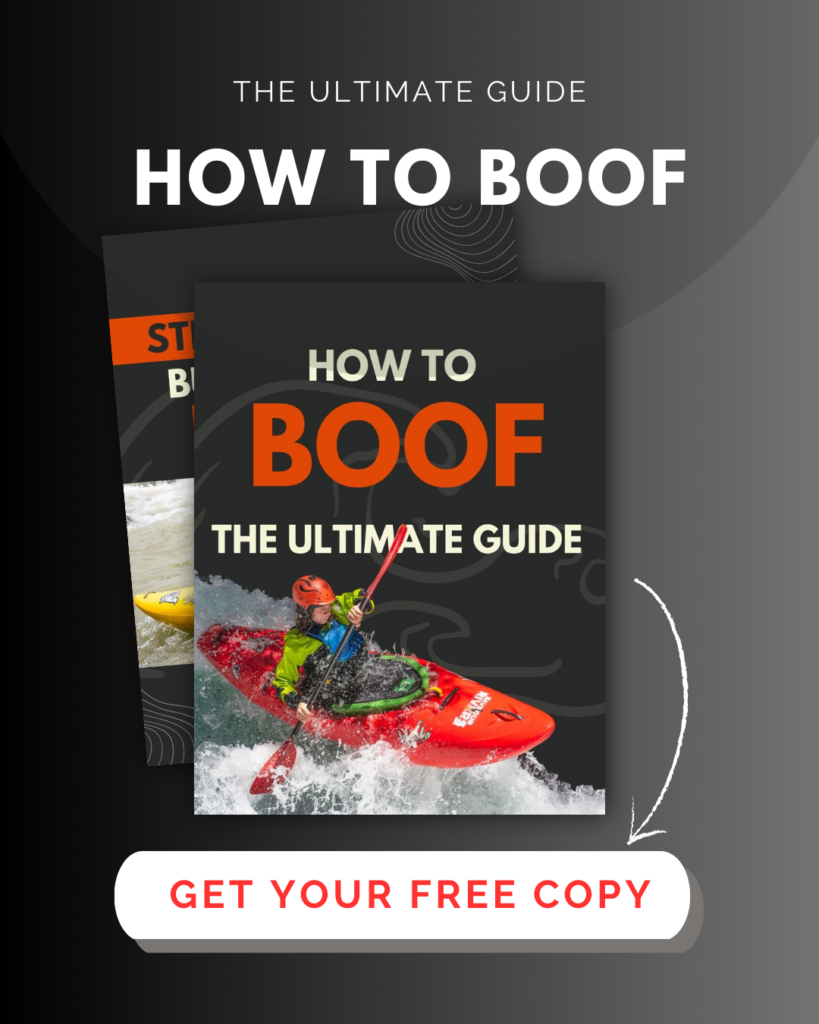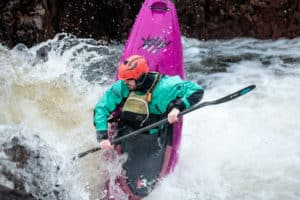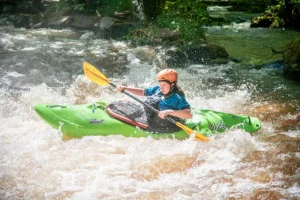Just like a standard Ferry, the Ferry Glide is the act of travelling from one side of a river to another.
You start from one Eddy and end up in an eddy on the opposite bank.
The idea is to not move downstream at all, or at least very much.
Ferry Glide: It’s in the name, you glide across.
This is such an important foundation to master as it will allow you to move about more comfortably on the river.
Not only that but as you progress the ferry glide will help you to scout rivers from your boat, hopping from eddy to eddy to get a better view of what’s over the horizon.
It will also allow you to get harder moves and avoid dangerous features on the river.
The Set Up
When you are first starting to learn the Ferry Glide, you want to find a slow-moving river, with two large eddies on either side.
From there you can build up to more powerful flows and smaller eddies.
Float down to the bottom of the eddy, right to the back.
Use some sense here, if your eddies are MASSIVE don’t make things harder for yourself – 2-3 boat lengths will do!
Face the boat upstream, pointing to the top of the eddy, where the seam line first starts to form.
The Approach
Using the flow of the water in the eddy to help pull you upstream, paddle to the top of the eddy.
Build up some speed to create momentum. But make sure you stay in control.
You don’t want to hit the eddy line and spin out.
As you approach the top of the eddy you want to be at a slight angle. Where directly upstream is 12 O’clock, you want to be at either 11 or 1 O’clock.
Let’s say you’re ferry gliding from a river right eddy to a river left eddy. I.e. From your perspective in your boat, you will be paddling upstream from the left and heading to your right.
In this case, you want to angle your boat to approximately 1 O’clock.
The slower the flow, the larger the angle can be. But for faster flows, you will need to point more upstream.
It’s best to start at a small angle and this will help stop you from spinning out.
The Edge
As you approach the seam line, you want to put a small edge on. Drop your downstream hip, and lift your upstream knee.
In this case, we’ll be lifting your left edge.
For ferry glides in slow flows, you don’t need much edge, put a small amount on to allow the water to flow underneath, but not enough to make you feel unstable.
For Ferry Glides on more powerful flows on harder rivers, you’ll want to whack that edge on hard – But you don’t need to worry about that now.
The harder the edge you apply, the more you will be pulled downstream. A small edge is perfectly fine for your first Ferry Glide!
The Ferry
As your bow crosses the seam line and into the flow, you should be pointing upstream at around 1 O’clock with a slight edge on.
The part that people find the hardest with the ferry is maintaining the angle.
The best way to maintain the angle is to keep paddling. Use sweep strokes to keep your bow pointing at that (imaginary) 1 O’clock mark.
As your bow crosses into the flow, it will be pushed downstream. To stop this, take a sweep stroke on your right.
If you maintain your angle and your edge you will find yourself gliding from one side of the river to another.
If you start to feel the angle increasing, take a sweep stroke to correct it.
You should keep paddling and you will eventually end up on the other side.
To increase the speed of your ferry, allow the angle to increase to 2 O’clock. To slow it down, point more upstream.
Just remember that the more angle you have, the harder it will be to get the nose to point upstream.
And the further downstream you will travel…
Breaking In
You can just keep the angle on until you are in the eddy, but personally, I can find that doing so can get a bit unstable in more powerful flows.
and as you are learning, it’s hard to know when to switch edges.
I like to stay more in control…
So…
As you are approaching the eddy you are (hopefully) aiming for.
Allow your angle to increase to 3 O’clock (make sure you keep your upstream edge up) and take a few strong forward strokes to pull yourself into the eddy.
Remember, that the water in the eddy is flowing in the opposite direction, so as you cross the eddy line you want to switch edges.
Keep paddling to make sure you are deep in the eddy and don’t get pulled back into the flow.
CONGRATS! You’ve just ferry-glided!
Now you need to do it on a real river, not an imaginary one….
Summary:
So in Summary, to Ferry Glide you want to:
- Set up in the back of the Eddy
- Build momentum and paddle to the top of the eddy
- Put an edge on, lifting your upstream hip
- Angle your kayak at either 11 or 1 O’clock, depending on the direction you want to travel.
- Maintain the angle with sweep strokes
- Break into the opposite eddy
For more Tutorials, check out our Learn Section!
